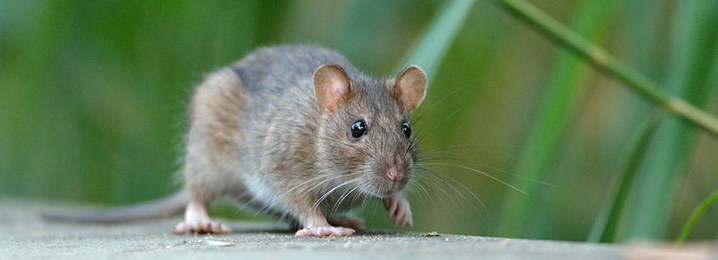Rat Prevention and Control
Urban areas provide excellent habitats for rats to survive. Rats are usually active at night and generally avoid contact with people. They prefer damp environments and often burrow and nest underground near building foundations, in garbage and in wood piles. Rats are carriers of disease, and health concerns can arise when they enter living spaces. In Ontario, it is most likely that a person would become ill from an infected rat as a result of ingesting food or water that has been contaminated by rat urine or droppings.
Rats may appear on the surface when sewers and drains are damaged, as well as during excavation work.
Rodents can also enter a home through various ways:
- an unused opening in the plumbing
- a broken pipe or a crack measuring more than 15 mm in a building wall
- meal scraps tossed in the toilet or a garbage disposal unit
Step One: Look for Evidence |
Inspect your property for signs of a rat infestation.
|
Step Two: Clean Up |
|
Cleaning up and getting rid of clutter is an essential step in rat prevention Wash Away Droppings and Track MarksRats communicate and attract each other through their urine and droppings.
Get Rid of ClutterClutter gives rats lots of places to hide, sleep, nest, and reproduce.
Control Weeds and Shrubs
|
Step Three: Eliminate Food and Water Sources |
|
Step Four: Rodent-proof Your Home |
Get rid of easy entry points into your home. Mice can squeeze through cracks as small as a dime, while rats can entre through quarter-sized holes. Even the small gaps created by worn thresholds under doors will allow mice access to your home.
|
Step Five: Traps and Bait |
| You may choose to hire a licensed pest control company due to the challenging nature of rat eradication. A number of physical and chemical control options are available to homeowners.
The safest and most effective method for controlling rat populations is trapping, however a number of chemical products exist as well. TrapsThere are several types of traps that can be used to control rats and mice. Snap traps and electronic traps are easy to use and very effective if well positioned and set properly. They generally kill rats and mice instantly. Live traps have trap doors that are triggered when rats or mice walk over them. Follow the manufacturer's directions on how to use a particular trap. These are general guidelines:
Note: It is important to check all types of traps daily. Ultrasonic devicesUltrasonic devices give off sound waves or vibrations that rats and mice dislike. Rats and mice may, however, adapt to the devices and return. It is recommended that ultrasonic devices be used along with other pest control options. ProductsRodent bait is a common way of controlling rats but applying these poisons is a job for professionals. If you use a pesticide to control your pest problem, read the label to make sure you are choosing the right product for the right pest. Follow all label directions and warnings carefully. Always look for a Pest Control Products (PCP) number on the label so you know the product has been approved by Health Canada
|
Safe Cleanup
Use caution when near urine and droppings:
- Wear rubber gloves and a dust mask during cleanup.
- Dampen droppings and debris with a solution of bleach and water before wiping up.
- Wear gloves to dispose of dead rats and mice.
- Double bag the bodies of dead rats and mice in plastic bags and put in a garbage bin with a secure lid.
- Wash hands and exposed clothing thoroughly after clean-up, and separate from other laundry.
- Never sweep or vacuum dry droppings. The dust that is raised can cause illness.













 Subscribe to this page
Subscribe to this page